Nuart returns to Aberdeen this weekend with a full program of murals, conference talks and screenings and this provides a good opportunity to look back at the undoubted highlight of last year’s event: Swoon‘s return to the streets for the first time since 2017. Following her retrospective at CIC Cincinnati, the Brooklyn-based artist, also known as Caledonia Curry, decided to shift focus to work on other pieces of her artistic puzzle, most notably the stop-motion animation Sibylant Sisters which is currently in production. But the draw of the streets and the opportunity put up work in the country from where her name derives was too great and Aberdeen was left with ten pieces of magic pasted around the city.
Caitlin
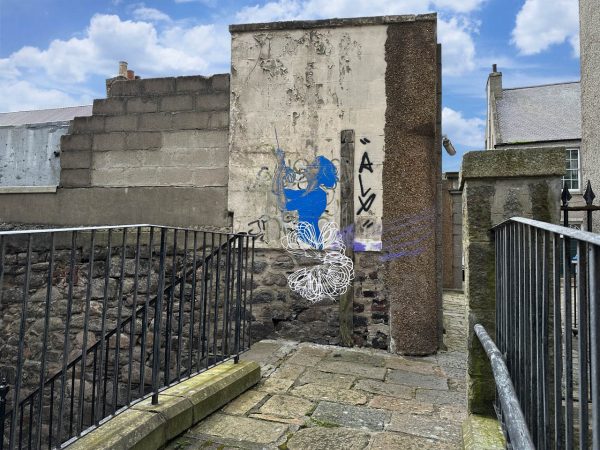
In the wake of the devastation wrought by Hurricane Katrina, Swoon and a group of friends teamed up with New Orleans Airlift to try to help revive the city’s arts scene. Swoon envisioned a playable, musical installation which would fuse two of the areas greatest cultural assets: music and architecture. The current iteration of the project features over 16 buildings and structures which have stages on which musicians can perform but also instruments embedded within their walls to create sonic, musical architecture intended to foster wonder, beauty and experimentation.
This particular image was originally created for the gates of the Music Box Village and depicts the New Orleans-based sculptor and preserver Caitlin Ezell Waugh; she’s pulling on a cable that is connected first to a pulley and then to a slide trombone. Beneath her is a motif based on Lissajous Curves which are generated by oscilloscopes and provide a visual representation of sound. But, more than this, Caitlin is a testament to creative collaboration with Taylor Lee Taylor (who designed much of the instrumentation), Darryl Reeves (a local local blacksmith who led the rigging of the musical houses) and hundreds of other creatives like Waugh who contributed towards making the Music Box Village a reality.
Aba
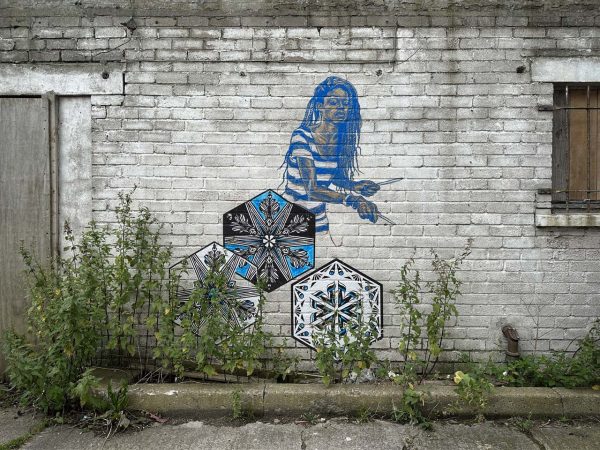
Another portrait which grew out the Music Box is that of Aba Essel, better known as Baaba Blacksheep who previously performed with the New Orleans punk band Gland and is now the lead singer with Oakland’s very own M80. Swoon grew up as a teenager in Daytona Beach listening to a healthy diet of punk rock and music has been a constant presence throughout her career.
Her first solo exhibition featured a soundscape and Japanther’s renegade, unpermitted performance out the back of a truck was a memorable feature of the opening of her landmarked 2005 show at Deitch Projects. In 2003, the Toyshop art collective, which she helped form, assembled a roving junk band which toured the streets of Manhattan entertaining bemused passers-by and she collaborated widely with Dark Dark Dark who became the effective house-band on the Swimming Cities rafts which sailed down Hudson River and across the Adriatic Sea. While waitressing in a New York diner, Swoon even featured in a music video for Thalia and a few years ago she gave us a peak into the music she listens to when working in the studio.
In this portrait, Aba plays a percussion set which is embedded in the Music Box Village and she is flanked by a scattering of hexagons whose patterns, such as that of an uncoiling fern in an ancient forest, were originally designed for tiles crafted at the Braddock Tile Project.
Bethlehem Boys
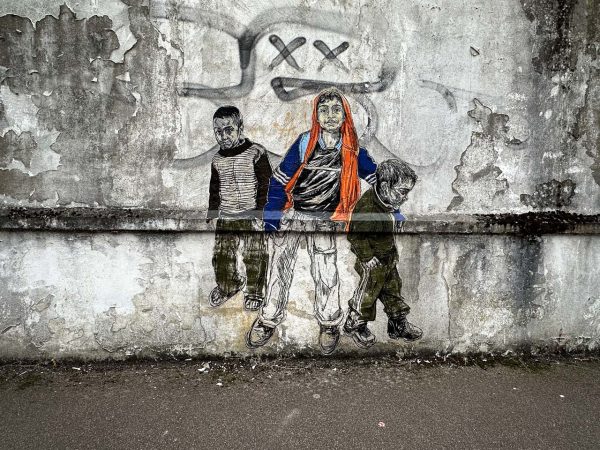
In 2007, Swoon was invited to take part in Santa’s Ghetto, Banksy’s then annual ‘squat art concept store’, which that year was decamping to Bethlehem in the West Bank. In addition to the exhibition in a former chicken restaurant in Manger Square, many of the artists including Blu, Know Hope and Paul Insect painted on the Separation Wall, which the International Court of Justice states is a violation of international law. Swoon pasted up images of Alice The Lacemaker, Girl from Rangoon Province and, on one of the Israeli watchtowers, Zahra; beneath the latter was a quote from Starhawk’s Webs of Power and hand-sewn pockets in which others could leave their own messages.
While putting up these streets pieces, Swoon saw a group of young Palestinian boys from the Aida refugee camp playing in the shadow of the 8m high wall. Looking back, Swoon recalls that “This is one of those prints that marks the moment when I first knew that I would want to try to find tenderness in a medium as stark and unforgiving as carving a sheet of linoleum with a knife.” The prominence of the wall makes it an alienating and oppressive presence, but in this group portrait, Swoon has compassionately captured the innocence and humanity of those children despite their having been forced to grow up in such an environment.
Sasu and Kasei
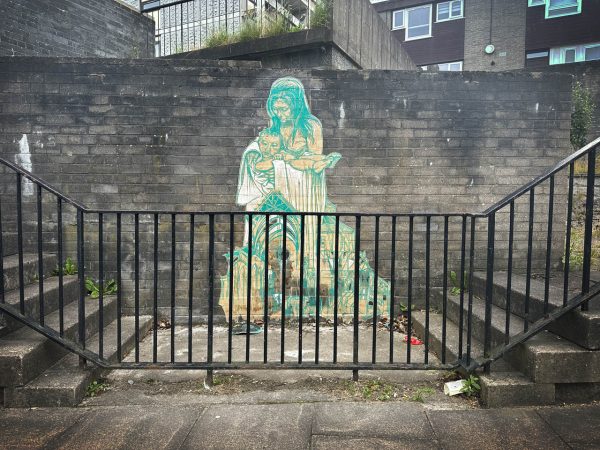
Sasu is one half of the artistic duo HITOTZUKI whom Swoon first met and exhibited alongside at the Ill Communication II exhibition in Manchester back in 2004. The husband and wife team were part of the infamous Barnstormers collective, alongside the likes of José Parlá and Maya Hayek, and her delicate geometric designs often take inspiration from the bounty of nature.
Aside from being an accomplished artist, Sasu is also a mother of two and this portrait captures her holding her eldest son Kasei after a bath. It is an activity which is at once both routine and unremarkable but also deeply devotional and ardently caring; this sense is emphasized in the piece in Aberdeen by the saintly viridian green which appears to almost glow against the soot-stained brick wall on which it is pasted. Hanging out late at night after the Ill Communication exhibition had opened, Swoon recalls a conversation between the two artists where Sasu attested to the importance of seeing from your heart because that’s your centre, rather than seeing from your head which looks down on the rest of yourself and believes itself to be separate. This feeling of assured wholeness permeates the portrait even as infant limbs sprawl out from the towel and she contends with the everyday challenges of motherhood.
Ten years on from the creation of the original image, this tender testament to maternal love was given a more humorous twist when Sasu recreated the image at Swoon’s Mirari Minima exhibition in Tokyo with a considerably more grown up Kasei!
Nicole

The eponymous subject of this both meditative and joyful portrait is the writer and designer Nicole Fenton who, like many of her subjects, is also a personal friend of Swoon. The image captures her when she was almost full-term with her daughter and her fecundity is reflected in the abundance of surrounding marine life; spotted jellyfish, pipe organ coral, devil rays and sea ferns all provide a throne for the majestic figure. At its heart, Aberdeen is a maritime city and fittingly Nicole can be found a short distance from the city’s almost 900 year old docks.
Nicole is the most recent in a series of works by Swoon which centre around pregnancy and motherhood. The first of these was Zahra, pregnant with her first child and possessing a sort of Artemisian inner strength and she-wolf protective instinct; Birth captures the moment of crowning and defies western art’s irrational and inexplicable taboo treatment of the subject; Dawn and Gemma is an intimate portrait of a mother breastfeeding her child and the softness of the embrace acted as a healing counterbalance for Swoon when confronting the hardship of her relationship with her own mother.
Walkie
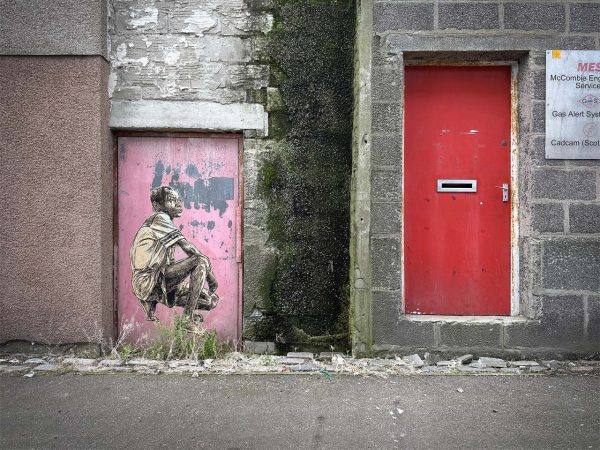
Late afternoon on 12th January 2010, a magnitude 7.0 earthquake struck Haiti killing over 100,000 people and destroying more than 300,000 homes and buildings. Swoon and a team of likeminded artists, engineers and builders came together with a common belief that the creative process and the use of local skills, materials and techniques would help in a time of crisis. A long-term relationship was established with the village of Komye, situated 15 miles west of the epicenter, and the Konbit Shelter project was formed. It takes it name from a Haitian Creole word for a traditional form of cooperative, communal labor and over the last 14 years the partnership has built a community center and three single-family homes, each designed and adapted with feedback from the community.
Walkie was a young boy from the village who often came to watch the construction of the super adobe-style community center and this is the first portrait that Swoon made after beginning work on the project. She went on to also create a portrait of Edline and since then local children have been able to attend the weekly Klub Obzevetwa which gives kids time to develop their creativity with the help of local teachers. Donations towards the ongoing running of the after-school club can be made via Swoon’s non-profit Heliotrope Foundation here.
Paulini and Rosemary

In 2012, Swoon visited the 160 Girls Project in Kenyan which seeks justice for the victims of sexual abuse and successfully sued the Kenyan National Police Force to compel them to enforce existing laws that would protect women and girls from rape. Under the leadership of Mercy Chidi Baidoo, the project has gone on to provide training to police departments across the country and runs the Tumaini safe house for girls in Kithoka where Paulini, on the left, and Rosemary, on the right, lived.
This particular piece shows traces many of Swoon’s artistic influences such as the college of children’s drawings connecting the two figures which is suggestive of the work of Robert Rauschenberg and Romare Bearden. Her predominant use of wheat pasting, which peels and degrades with time, embraces Gordon Matta-Clark’s thoughts on the transience of life and how some things are just not meant to last. But, more specifically with this piece, there is an awareness of the importance of site-specific context; Aberdeen is known as the Granite City, as a result of the high proportion of buildings which have been hewn from the rock retrieved from quarries dotted around the local area and the placement of this piece on these granite walls both embeds the work in the physical soul of the city and provides a contrast between the flat pastel shades of the work and the rough darkness of the stone. But, more than anything, Swoon is the heir to Käthe Kollwitz’s compassionate expressionism and this work is imbued with the German artist’s Goethean mantra that “Seed for sowing should not be milled”.
Monica

Swoon’s first portrait of the Oakland-based artist Monica Canilao dates back to 2010. The portrait is a whirlwind of tattered bedsheets and flowing lace; extraneous limbs and fly-away hair; feathers and flowers, all caught in the maelstrom. Throughout the portrait, Canilao’s idiosyncratic sense of style is evident from the fox adorning her head and the bold, handmade jewellery she wears, to her tattoo of a dove shot through with arrows and misfit makeup which is perceptible even in monochrome.
Working in a broad range of mediums, Canilao’s work is a visual record of a living history. Her own experiences are intertwined with remnants of past lives through the use of found materials in her work and Swoon has brought this foundational aspect of Canilao’s work into the portrait by drawing her resting on a giant portrait of an ancestor.
Swoon has described Monica as equal parts muse and wifey and it’s a creative partnership which has spawned a diverse and enduring range of collaborations from creating works on the whitewashed walls of Djerba in Tunisia to the underwater Amniotic installation with Chandran Gallery at Miami Basel in 2014. They have exhibited together on a number of occasions including at Black Rat Projects in London in 2007 and at their joint Witch Wife show in San Fransisco almost a decade later.
Moni and the Sphinx
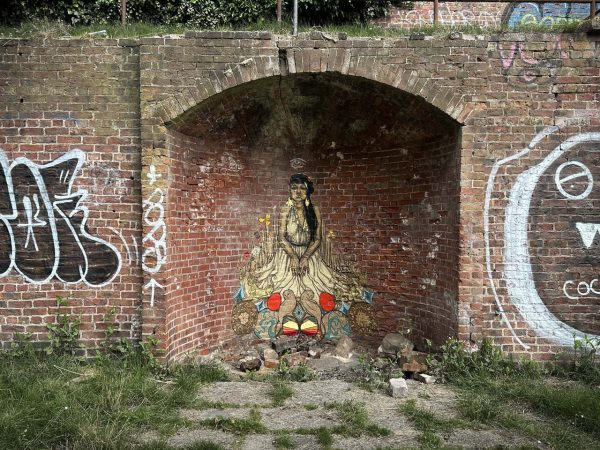
In August 2016, Swoon returned to the subject of the women that she describes as her “most singular muse and collaborator”. This statuesque iteration of Canilao is rich with symbolism and creates what she describes as a “looping narrative about the instinctual nature of the psyche, growth, abundance, boundaries and protection.” When she was 17, Swoon spent a year in Prague as an exchange student sating her appetite for the work of Egon Schiele and the Medusa-esque sphinxes in this work reference the huge stone versions which guard the entrance to the National Library. Over recent years, Swoon has undertaken deep therapeutic work to confront her traumatic upbringing and family life; during this time she encountered a pair of owls while walking in the forest and the birds continued to appear symbolically throughout a given day. They appear in this portrait at the feet of Moni acting as a source of strength and courage.
Monica’s own expressiveness and creativity is celebrated in part through a series of soon-to-be hatching eggs, flowing rivers and flowering irises, all of which were drawn from imagination. But, more fundamentally, lines which correspond with the folds of her dress give the impression of her innate creativity flowing from her patiently drawn hands out into the world.
Milton II (Diogenes)

This portrait of Swoon’s father Milton was created in the months following his passing in 2015, when she was trying to come to terms with her loss and grief. Milton had been addicted to heroine, but got clean when Swoon was four years old and supported her throughout her career. He is described as having never quite “got free of the tensions that bound him” and he is depicted here as an old man in his wilderness searching for what would come next.
Hidden away where the paper has been pasted into the corner of a step is a ribbon inscribed with words which Swoon saw written on a picture on her father’s bookshelf “I have been where you are now, and you will be where I have gone.”
The work references both Ilya Repin’s painting of Leo Tolstoy Barefoot and the teachings of Diogenes, who was one of the founders of the philosophical school of Cynicism. Swoon recalls her father telling the the story of when Diogenes, sat on the roadside eating lentils, met Aristippus; the latter argued that, “If you would learn to be subservient to the king, you would not have to live on lentils” to which Diogenes retorted, “if you learn to live on lentils, and you will not have to cultivate the king.” This lesson in the meaning of freedom appears to have left a lasting impression on Swoon helping her to go out into the world and create the impossible, from Adriatic flotillas and Haitian community centres to works which bust taboos and help us all to see the world differently.
Photo credit: feralthings



